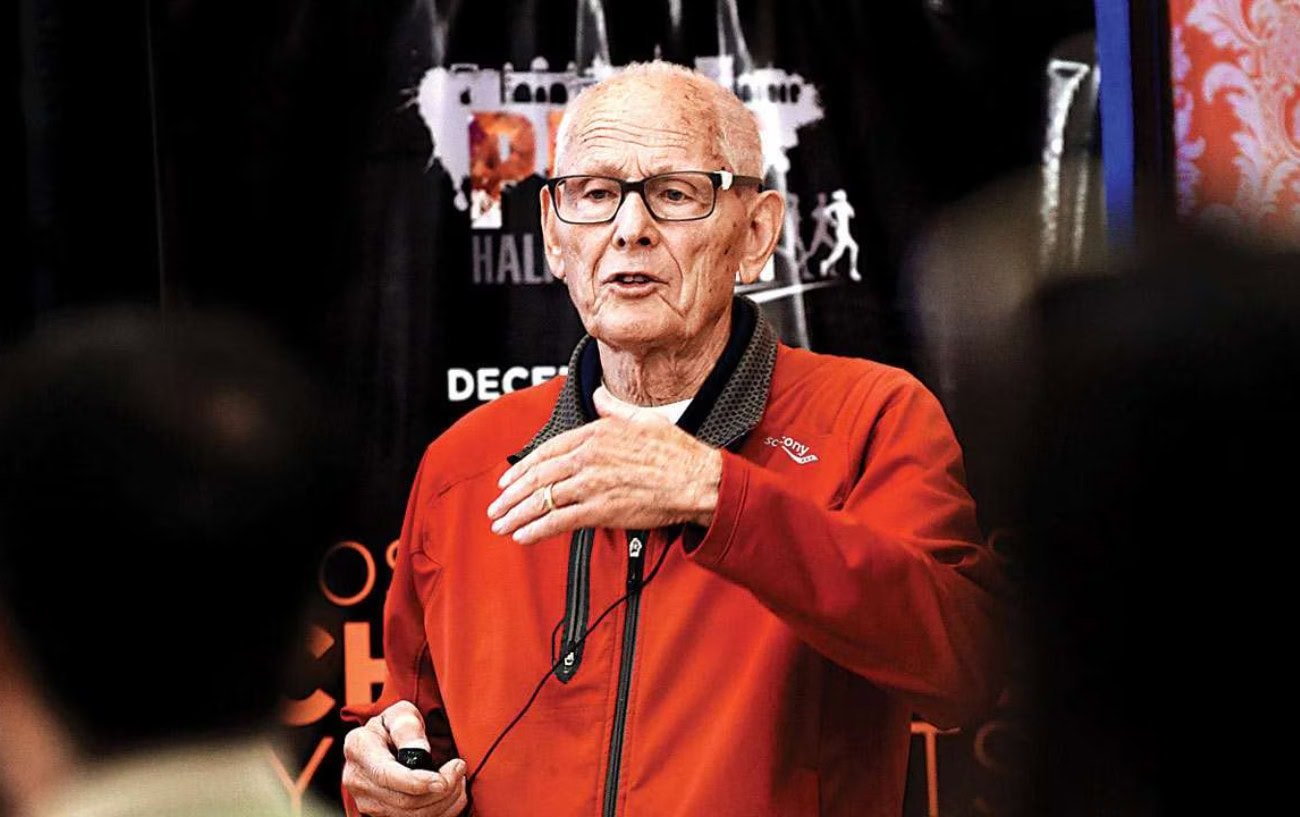Ever find yourself staring at your running shoes, but suddenly the couch looks a lot more appealing?
Maybe you start scrolling YouTube, remember you need to do the dishes, or convince yourself that you’ll just run “later.” Sound familiar?
It’s totally normal, we all experience highs and lows in motivation. But the difference between runners who consistently show up and those who struggle often comes down to one thing:
Systems.
Systems are the routines, processes, and cues we put in place that make follow-through more likely. They remove the need to rely on willpower and help transform actions into habits.
Over the years, I’ve built a set of go-to habits that keep me running, even when I’d rather stay inside. Here’s what’s worked for me.

How Habits Actually Work
Before diving into the seven habits, let’s look at the science behind habit formation.
A strong habit has four key components:
- Cue – A trigger that tells your brain to begin the behavior (e.g., you’ve planned a 10K run).
- Craving – The motivation behind the habit (e.g., you start feeling an itch to move or clear your head).
- Response – The actual behavior (e.g., you lace up and go for the run).
- Reward – Something satisfying that completes the loop and makes your brain want to repeat it.
This loop explains how habits stick and why some routines feel automatic over time.
(If you want to go deeper into this topic, check out the book list at the end of the post.)

Habit 1: Have a Training Plan
One of the best ways to stick to a running routine is to take out the guesswork, and that starts with a plan.
A training plan acts as a system. It defines:
- When you’re running
- Where you’re running
- How far you’re going
- At what pace or intensity
Why does this matter?
Because goals are vague, but systems are specific.
Saying “I want to run more” is a good intention, but without a plan, it’s easy for life to get in the way. On the other hand, “I run 10K every other day at 6 p.m. along the riverside trail” leaves no room for debate.
Goals focus on the end result. Systems focus on the daily process. And you don’t rise to the level of your goals, you fall to the level of your systems.
If you’re training for a race, a structured plan maps out the mileage, pace, recovery days, and progression. You’re doing the hard mental work once, up front. Then each day, all you have to do is follow the blueprint.
Once it’s on the calendar, it becomes routine.
✅ Pro tip: Browse our training plan library to find a structured plan tailored to your goals.
If you’re not following a race plan, you can still build a simple daily system, such as running 3 or 5 miles every day. These “mileage habits” can be surprisingly powerful and lead to big gains over time.
Habit 2: Prime Your Environment
Want to run more? Set up your environment to make it easier.
This habit is all about reducing friction and increasing your exposure to cues that encourage running. It’s about turning your space into a subtle motivational machine.
Here’s how I do it:
- Shoes by the front door – It’s a visual cue. I can’t ignore them.
- Running clothes prepped in the morning – Whether I’m running after work or midday, I lay out my gear so I’m not scrambling later.
- Running podcasts during my commute – I listen to stories about training, gear, or race recaps on the way to work. It gets me thinking like a runner before I even lace up.
- Entertainment ready – I plan out a podcast or audiobook for my run. This becomes part of the reward, something I genuinely look forward to.
These steps may seem small, but together they create an environment that pushes me gently toward lacing up.

Habit 3: Remove Any Resistance
If something small makes your run feel harder, it’s a form of resistance, and resistance kills habits.
This is about identifying the obstacles that typically derail your runs and addressing them before they arise.
Here are a few I’ve encountered and how I solve them:
- Obstacle: I finish my run late and realize there’s no dinner.
- Fix: Keep emergency meals (like instant noodles or frozen burritos) on hand so I’m not tempted to skip the workout.
- Obstacle: It’s unusually cold outside.
- Fix: Make sure I have thermal layers, gloves, and a beanie at the ready. I even check the weather the night before to mentally prepare.
- Obstacle: Family obligations after work.
- Fix: I communicate my training schedule in advance to my partner and kids. If I’m planning a run at 6:30 p.m., we plan dinner or hangout time around it.
Anticipating resistance, and planning around it, is like giving your future self a huge advantage.
Remember, even small bits of friction can become deal-breakers when motivation is low. Eliminate them before they appear.
Habit 4: Track and Share Your Runs
Once I finish a run, I log it immediately on Strava. I’ll even add a couple of photos if I have my phone with me.
Why? Because tracking makes progress visible, and sharing adds a social dimension that boosts accountability.
When I see my week’s runs stack up in Strava, I feel momentum. When friends comment or give kudos, it reinforces the behavior. That little dopamine hit from seeing someone like your run? That’s part of the reward loop.
Strava isn’t the only option, Garmin Connect, MapMyRun, and Nike Run Club offer similar features.
You don’t have to be super active in the community, either. Even quietly following a few friends can provide that motivational nudge.
And when I upload runs regularly, I can compare paces, routes, and mileage over time. It becomes a low-key performance tracker.
Bottom line, sharing adds a layer of fun and reinforcement that keeps me coming back for more.
Habit 5: Find Something Interesting To Listen To While You Run
I love listening to audiobooks and podcasts, and I use them as a carrot to get me out the door.
In fact, I often save episodes or chapters for my run, which gives me something to look forward to. It becomes part of the ritual.
This technique is called temptation bundling, pairing something you want (entertainment) with something you should do (exercise).
If I’m deep into a thriller audiobook or a new podcast series, I want to run, just so I can hear what happens next.
You don’t have to be into long-form content, either. Music, short shows, or comedy podcasts all work, just pick something you genuinely enjoy.
Over time, your brain starts associating “running time” with “entertainment time,” which makes getting started feel easier.

Habit 6: Reward Yourself With a (Healthy) Snack
Habits stick when they include a satisfying reward, and for me, it’s a post-run snack.
After a morning run, I scramble eggs and make a hot cup of tea. If it’s an evening session, I go for a quick smoothie, usually protein powder, banana, peanut butter, and maybe some flax or chia seeds.
Whatever you choose, make sure it checks these boxes:
- Healthy – Try to include protein and healthy fats.
- Simple – Keep ingredients handy and prep time minimal.
- Satisfying – Choose something you genuinely enjoy.
This mini reward acts as the closing loop for the habit. Your brain links “run complete” with “positive outcome,” which reinforces the routine.
Over time, you’ll start associating your run not just with effort, but with comfort and satisfaction too.
Habit 7: Make Your Run The End of Your Day
When I run in the evening, I try to clear my to-do list beforehand. Why? Because it lets my run become the final “task” of the day.
Instead of dreading the run or seeing it as another obligation, it becomes a mental sign-off. It’s how I draw the line between work mode and relax mode.
Knowing that I’ve already wrapped up chores, emails, and errands makes the run feel like a reward rather than a burden.
Plus, it gives me something to look forward to. It’s not just exercise, it’s transition. It’s my way of mentally saying, “Day’s done. You earned this.”
Motivation comes and goes. But habits, and the systems behind them, are what carry you through the low days.
None of these habits are complicated. They’re small shifts that, together, make running feel easier, more automatic, and even enjoyable.
Which habits have worked for you? Drop a comment below and share your go-to strategies!
Recommended Reading List
The Power of Habit by Charles Duhigg
Explores the science of habit formation with memorable case studies and real-world examples. Introduces the habit loop (cue → routine → reward).
Atomic Habits by James Clear
A practical, actionable guide to building habits that stick. Introduces the 4-step loop (cue → craving → response → reward), and emphasizes the power of systems and environment.
Willpower: Rediscovering the Greatest Human Strength by Roy F. Baumeister
Looks at willpower as a limited daily resource. Offers insights into how to protect your energy, avoid burnout, and structure your day for better self-control.













I work in an office all day so I always take my dog out for walks first (he can’t run with me his legs are too short) This allows me to warm up a bit and see how warm/cold it is so I can dress appropriately
I have a dry erase board I keep in my kitchen where I write down my training plan for the month, complete with any cross-training I plan to do. It helps me know what’s coming up for the week, and during the week I run immediately after work. I work from home, so I usually change clothes for running during my last 30 minutes of work so that I can head out as soon as I log off for the day. It’s a fantastic cleanse after a long day of staring at a computer screen, and then I can relax after I get home. I’m training for my first full marathon, and my running buddies have commented on how consistent I am. That dry erase board has really helped a ton with my motivation.
I always run in the morning. Weekdays I run from a gym just a few minutes from my work, so I change into my running kit, put my work clothes and my breakfast in my kit bag (packed the night before), get everything into the car, leave early and am then ahead of the traffic’s queues at rush hour. I then have 2 options, run outdoors which is my preference, or if the weather is awful, I run on a treadmill in the gym. Either way I use the gym to shower and change for work. Then drive the short distance to the office where there is a microwave and have breakfast at the computer (porridge mixed with protein powder and milk). Coffee on tap and fully energised for a day at work. Weekends, I still run early morning but everything is at home then.